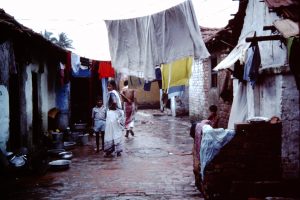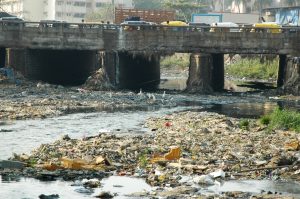In the country’s richest municipal corporation, human waste from 36,883 households of the total 26,65,479 are disposed into open drains (Lukose, 2015).

Barriers to Safe Water
The Problem:
- Lack of access to sanitation and clean water
- Forces urban poor to find ways to cope that have consequences for all city residents, inside and outside of slums.
No legal access to central water supply:
- Government maintains chlorinated central water supply, however, people living in non-notified slums have been historically unable to tap into city water pipes out of desperation – a survival strategy that can compromise the safety of the water supply through cross-contamination (WHO, 2015)
- Not to say that problems of sanitation only become an issue when they affect a certain population, but rather to highlight the widespread wickedness and effects of poor sanitation in Mumbai.
Price:
- Mumbai’s poor sanitation affects the urban poor by disproportionately increasing the price they pay for water.
- Residents in slums that are excluded from the formal water supply are forced to buy water from street vendors
- This water is up to 40 times more expensive than what they would be paying through a formalized system (WHO, 2015).
- This predatory and unjust system serves to further trap residents in cycles of poverty and poor sanitation.

A Need for Coordinated Intervention
- NGOs and CBOs work within slums to address sanitation problems
- Society for Promotion of Area Resource Centres (SPARC), National Slum Dwellers Federation (NSDF), and Mahila Milan work with slum residents to construct toilet facilities.
- Projects aim to empower slum dwellers by involving them in design, construction, and maintenance of facilities.
- SPARC has participated in constructing 298 toilet blocks in Mumbai and continues similar work in other cities in India (SPARC, 2014)
Rapid Urban Growth
- Increasing rates of urbanization and failure to understand the local context of everyday life in slums allows sanitation problems to persist and worsen (Desai, McFarlane & Graham, 2016)
- Mumbai Sustainability and Corporate Citizen Protocol (Asian Centre, 2009) work to address environment and sustainability concerns in the city.
- These concerns need to be echoed and prioritized through a combination of state policy and local engagement.
Investments Strengthen the Community
Please take a minute to watch the following short videos to see how investments in sanitation infrastructure benefits slums and fosters a sense of community.
References:
Asian Centre for Corporate Governance and Sustainability: Mumbai Sustainability and Corporate Citizenship Protocol. 2009. Available online: http://www.asiancentre.org/Mumbai_Sustainability_and_Corporate_Citizenship_Protocol_N1.pdf [Accessed: 28 March 2017]
Desai, Renu; McFarlane, Colin; Graham, Stephen; University of Durham. 2016. Everyday Sanitation: A comparative study of Mumbai’s informal settlements. [ONLINE] Available at: https://www.dur.ac.uk/geography/everyday_sanitation/. [Accessed 28 March 2017].
Girish Menon,PRATHA. (2009). A documentary film on Slum Sanitation in Mumbai . [Online Video]. 7 March 2009. Available from: https://www.youtube.com/watch?v=iiocQyMSnSw. [Accessed: 28 March 2017].
Lukose, A. (2015). Dirty Mumbai: 6,400 Tonnes of Solid Waste, 40 pc Sewage Go Untreated. The Indian Express
Sparcindia.org. (2014). Sanitation. [online] Available at: http://www.sparcindia.org/sanitation.php [Accessed 4 Mar. 2017].
World Health Organization (2015) The right to water in the slums of Mumbai, India. 2015. Bulletin of the World Health Organization 2015;93:815-816 http://www.who.int/bulletin/volumes/93/11/15-155473/en/